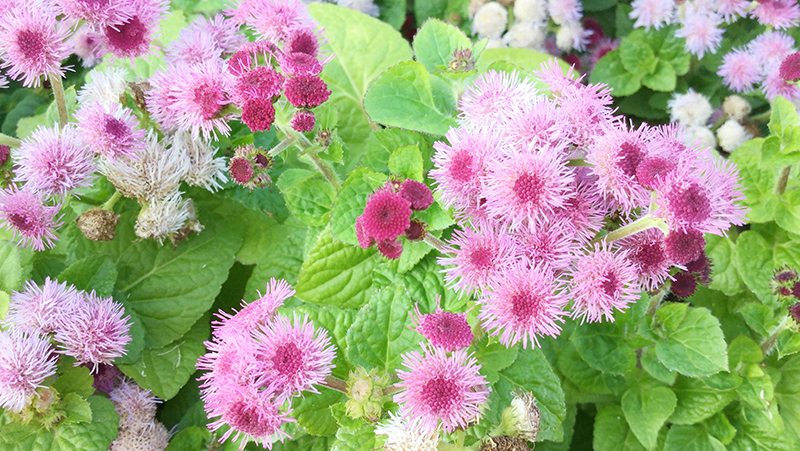Yates Account
Join now
Create a Yates account today!
Sign up to join the Yates Garden Club for monthly e-mails packed with seasonal inspiration, tips for success & exclusive promotions.
Plus if you’re a Garden Club member you can take part in the Yates Growing Community - a blog to share successes, get advice & win prizes in fun challenges along the way!

Forgot password
Enter the email address associated with your account, and we'll email you a new password.

Ageratum (Ageratum houstonianum) are a delightful dwarf plant with soft, fluffy blue, purple, pink or white flowers. They are excellent as a display in pots, window boxes, as a border or for cut flower indoor decoration. Great for attracting bees to the garden.
How to grow Ageratums in a garden
Starting from seed:
- Fill starter pots or trays with Yates Black Magic Seed Raising Mix.
- Sow seeds, lightly cover with mix, firm down and gently water in well.
- Water gently and keep mix moist at all times until seeds have germinated.
- While seedlings are growing, choose a full sun to part shade position with well-drained soil.
- Enrich the soil with Yates Dynamic Lifter Organic Plant Food.
- Allow the seedlings to grow to at least 7 cm before transplanting.
- When transplanting into prepared garden bed, ensure seedlings are well spaced – at least 15 to 20cm apart.
- Water in well.
- Mulch with an organic mulch such as bark chips, woodchip or pea straw to a depth of 5 - 8cm.
- Feed with Yates Thrive Rose & Flower Granular Plant Food. TIP: for an added boost, apply Yates Thrive Roses & Flowers Liquid Plant Food.

How to grow Ageratums in a pot
Starting from seed:
- Choose a pot at least 200mm wide and deep.
- Position in full sun to part shade.
- Fill pot with a premium quality potting mix such as Yates Premium Potting Mix.
- Sow seeds directly into pot, lightly cover with mix, firm down and gently water in well.
- Keep mix moist at all times until seeds have germinated.
- Feed with Yates Thrive Rose & Flower Granular Plant Food. TIP: for an added boost, apply Yates Thrive Roses & Flowers Liquid Plant Food.
Growing tips
- Lightly trim back the plant after the flushes of flowers. This will encourage new growth and further flowering.
- Ensure plant is kept lightly moist at all times and the soil is not allowed to dry out. Extra watering may be required during hot spells.
System.NullReferenceException: Object reference not set to an instance of an object. at Umbraco.Cms.Core.Models.PublishedContent.PublishedContentType..ctor(IContentTypeComposition contentType, IPublishedContentTypeFactory factory) at Our.Umbraco.DocTypeGridEditor.Helpers.DocTypeGridEditorHelper.<>c__DisplayClass15_0.<GetContentTypesByAlias>b__0() at Umbraco.Extensions.AppCacheExtensions.<>c__DisplayClass5_0`1.<GetCacheItem>b__0() at Umbraco.Cms.Core.Cache.SafeLazy.<>c__DisplayClass1_0.<GetSafeLazy>b__0() --- End of stack trace from previous location --- at Umbraco.Cms.Core.Cache.ObjectCacheAppCache.Get(String key, Func`1 factory, Nullable`1 timeout, Boolean isSliding, String[] dependentFiles) at Umbraco.Cms.Core.Cache.ObjectCacheAppCache.Get(String key, Func`1 factory) at Umbraco.Cms.Core.Cache.DeepCloneAppCache.Get(String key, Func`1 factory) at Umbraco.Extensions.AppCacheExtensions.GetCacheItem[T](IAppCache provider, String cacheKey, Func`1 getCacheItem) at Our.Umbraco.DocTypeGridEditor.Helpers.DocTypeGridEditorHelper.GetContentTypesByAlias(String contentTypeAlias) at Our.Umbraco.DocTypeGridEditor.Helpers.DocTypeGridEditorHelper.ConvertValue(String id, String contentTypeAlias, String dataJson) at Our.Umbraco.DocTypeGridEditor.Helpers.DocTypeGridEditorHelper.RenderDocTypeGridEditorItem(IViewComponentHelper helper, IHtmlHelper htmlHelper, Object model) at AspNetCoreGeneratedDocument.App_Plugins_DocTypeGridEditor_Render_DocTypeGridEditor.ExecuteAsync() at Microsoft.AspNetCore.Mvc.Razor.RazorView.RenderPageCoreAsync(IRazorPage page, ViewContext context) at Microsoft.AspNetCore.Mvc.Razor.RazorView.RenderPageAsync(IRazorPage page, ViewContext context, Boolean invokeViewStarts) at Microsoft.AspNetCore.Mvc.Razor.RazorView.RenderAsync(ViewContext context) at Microsoft.AspNetCore.Mvc.ViewFeatures.HtmlHelper.RenderPartialCoreAsync(String partialViewName, Object model, ViewDataDictionary viewData, TextWriter writer) at Microsoft.AspNetCore.Mvc.ViewFeatures.HtmlHelper.PartialAsync(String partialViewName, Object model, ViewDataDictionary viewData) at AspNetCore.Views_Partials_grid_editors_base.ExecuteAsync() in C:\home\site\wwwroot\Views\Partials\grid\editors\base.cshtml:line 23
Orange trumpet vine, with its brilliant cascading masses of orange tubular flowers, is one of the most spectacular winter flowering climbers.
Spring Stars
Spring Stars are a versatile addition to any garden with delightful lavender-blue, star shaped blooms.
Flax
Flaxes (Phormium spp.) are highly versatile plants which don't mind swampy or dry conditions. Great for large pots or planted en-masse in garden beds.
Proteas
Not just any old blossom, protea flowers are blooms with attitude. If you can give them full sun and reasonable drainage, proteas will love you.
Recommended products
Yates Thrive Rose & Flower Granular Plant Food
Specially formulated to grow all types of flowers. With high potassium for large & abundant flowers, added calcium & iron for stronger flowers.
Yates Thrive Roses & Flowers Liquid Plant Food
Provides your flowers & roses with the balanced nutrients they require for healthy growth and flower production.
Yates Dynamic Lifter Organic Plant Food
Releases nutrients slowly, improves the structure and moisture retention of the soil and encourages earthworms and beneficial soil micro-organisms.
Yates Premium Potting Mix
A premium potting mix, ideal for all potted plants and shrubs, including ornamentals, fruit trees, vegies and herbs.
















Share
Share this article on social media